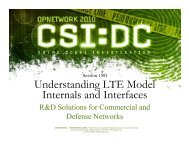Understanding TCP/IP Model Internals and Interfaces
Understanding TCP/IP Model Internals and Interfaces
Understanding TCP/IP Model Internals and Interfaces
Create successful ePaper yourself
Turn your PDF publications into a flip-book with our unique Google optimized e-Paper software.
1508 <strong>Underst<strong>and</strong>ing</strong> <strong>TCP</strong>/<strong>IP</strong> <strong>Model</strong> <strong>Internals</strong> <strong>and</strong> <strong>Interfaces</strong><br />
Lab 2 Answers: <strong>TCP</strong> Flavor Comparison<br />
<strong>TCP</strong> Reno:<br />
1. What was the congestion window before the packet loss was detected? 12,864 Bytes<br />
2. What was the congestion window after the loss was detected? 8,040 Bytes<br />
3. Why did the congestion window keep increasing after the loss was detected?<br />
This is due to the arrival of duplicate ACKs.<br />
4. Why did the congestion window stay flat for a large period?<br />
Sender could not send new data, it had to wait for a retransmission timer to expire<br />
Note: You can typically conclude this whenever you see a large gap when no data is sent.<br />
5. How did the server recover from packet loss – using fast retransmit or timeout retransmission?<br />
Retransmission timeout expiration<br />
6. How many times was a slow start performed during the session lifetime?<br />
Twice – when the session started <strong>and</strong> when the timer expired.<br />
7. How many segments were retransmitted? 3<br />
8. Were any segments retransmitted unnecessarily? No<br />
9. When is the last segment sent? At about 2.6 seconds<br />
<strong>TCP</strong> SACK<br />
1. What was the congestion window before the packet loss was detected? 12,864 Bytes<br />
2. What was the congestion window after the loss was detected? 6,432 Bytes<br />
3. Why did not congestion window change after retransmission?<br />
<strong>TCP</strong> SACK does not use congestion window to decide when to send a packet during fast<br />
recovery. It has its own algorithm that uses an estimation of how much data is outst<strong>and</strong>ing.<br />
4. How many segments were retransmitted? 3<br />
5. Were any segments retransmitted unnecessarily? No<br />
6. When is the last segment sent? About 1.2 sec<br />
Comparison across Scenarios<br />
1. Which flavor results in the lowest application response time? Reno with ECN<br />
CONFIDENTIAL – RESTRICTED ACCESS: This information may not be disclosed, copied, or transmitted in any format without the prior written consent of OPNET Technologies, Inc.<br />
© 2010 OPNET Technologies, Inc.<br />
45
















